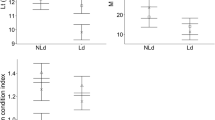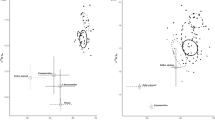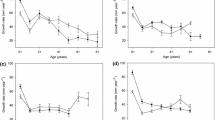Abstract
Invasive species and anthropogenic sources of allochthonous trophic subsidies can have substantial ecological consequences for freshwater ecosystems, including modifying the diet of consumers and altering food web structure. Here, the diet of an omnivorous cyprinid fish, European barbel Barbus barbus, was assessed in relation to the presence of invasive signal crayfish Pacifastacus leniusculus and pelletized fish-meal in four rivers in England. Pellets are often used in large quantities by river anglers and thus could provide an important trophic subsidy, not only to the fish but also indirectly via P. leniusculus. Carbon and nitrogen stable isotopes were used to estimate the proportion of diet assimilated from natural sources and from P. leniusculus and pellets by B. barbus of lengths between 420 and 800 mm. Pellets generally made a large contribution to the overall biomass of B. barbus (up to 59 % of population diet) and in the two rivers where they were present, P. leniusculus were also an important resource (up to 30 % of population diet). The proportion derived from macro-invertebrates (excluding P. leniusculus) was substantially lower. Stable isotope mixing models further demonstrated considerable intraspecific variability in B. barbus diet within the rivers, with pellets comprising up to 79 % of the biomass of individual B. barbus in rivers where P. leniusculus was absent. Where present, P. leniusculus effectively replaced and thus reduced the contribution of pellets to individual fish diet. Thus, isotopic evidence from three of the four rivers indicates that B. barbus populations are heavily reliant (>50 %) upon angler-introduced baits that act as an important allochthonous subsidy and will also prey upon invasive P. leniusculus where they are present.


Similar content being viewed by others
References
Arlinghaus R, Niesar N (2005) Nutrient digestibility of angling baits for carp, Cyprinus carpio, with implications for groundbait formulation and eutrophication control. Fish Man Ecol 12:91–97
Baras E (1995a) Seasonal activities of Barbus barbus L.: effect of temperature on time-budgeting. J Fish Biol 46:816–828
Baras E (1995b) Thermal related variations of seasonal and daily spawning periodicity in Barbus barbus. J Fish Biol 46:915–917
Beja PR (1996) An analysis of otter Lutra lutra predation on introduced American crayfish Procambarus clarkii in Iberian streams. J Appl Ecol 33:1156–1170
Blake MA, Hart PJB (1995) The vulnerability of juvenile signal crayfish to perch and eel predation. Freshw Biol 33:233–244
Bobeldyk AM, Lamberti GA (2010) Stream food web responses to a large omnivorous invader, Orconectes rusticus (Decapoda, Cambaridae). Crustaceana 83:641–657. doi:10.1163/001121610X49103
Britton JR, Pegg J (2011) Ecology of European Barbel Barbus barbus: implications for river, fishery, and conservation management. Rev Fish Sci 19:321–330. doi:10.1080/10641262.2011.599886
Britton JR, Davies GD, Harrod C (2010) Trophic interactions and consequent impacts of the invasive fish Pseudorasbora parva in a native aquatic foodweb: a field investigation in the UK. Biol Invasions 12:1533–1542. doi:10.1007/s10530-009-9566-5
Britton JR, Pegg J, Davies GD (2012) Spatial variation in the somatic growth of European barbel Barbus barbus: a UK perspective. Ecol Freshw Fish 22:21–29
Cherghou S, Khodari M, Yaâkoubi F, Benabid M, Badri A (2002) Contribution to study a barbel (Barbus barbus callensis Valenciennes, 1842) diet in Morrocain Medium-Atlas stream: oued Boufekrane. Revue des Sci de l’Eau 15:153–163
Correia AM (2001) Seasonal and interspecific evaluation of predation by mammals and bird on the introduced red swamp crayfish Procambarus clarkii (Crustacea, Cambaridae) in a freshwater marsh (Portugal). J Zool 255:533–541
Corse E, Costedoat C, Chappaz R, Pech N, Martin JF, Gilles A (2010) A PCR-based method for diet analysis in freshwater organisms using 18S rDNA barcoding on faeces. Mol Ecol Res 10:96–108. doi:10.1111/j.1755-0998.2009.02795.x
Coulas RA, Macisaac HJ, Dunlop W (1998) Selective predation on an introduced zooplankter (Bythotrephes cederstroemi) by lake herring (Coregonus artedii) in Harp Lake, Ontario. Freshw Biol 40:343–355
Demétrio JA, Gomes LC, Latini JD, Agostinho AA (2012) Influence of net cage farming on the diet of associated wild fish in a Neotropical reservoir. Aquaculture 330–333:172–178. doi:10.1016/j.aquaculture.2011.11.026
Ellis BK, Stanford JA, Goodman D, Stafford CP, Gustafson DL, Beauchamp DA, Chess DW, Craft JA, Deleray MA, Hansen BS (2011) Long-term effects of a trophic cascade in a large lake ecosystem. Proc Natl Acad Sci USA 108:1070–1075
Fernandez-Jover D, Arechavala-Lopez P, Martinez-Rubio L, Tocher DR, Bayle-Sempere JT, Lopez-Jimenez JA, Martinez-Lopez FJ, Sanchez-Jerez P (2011a) Monitoring the influence of marine aquaculture on wild fish communities: benefits and limitations of fatty acid profiles. Aquac Environ Interact 2:39–47. doi:10.3354/aei00029
Fernandez-Jover D, Martinez-Rubio L, Sanchez-Jerez P, Bayle-Sempere JT, Lopez Jimenez JA, Martínez Lopez FJ, Bjørn PA, Uglem I, Dempster T (2011b) Waste feed from coastal fish farms: a trophic subsidy with compositional side-effects for wild gadoids. Estuar Coast Shelf S 91:559–568. doi:10.1016/j.ecss.2010.12.009
Garvey JE, Rettig JE, Stein RA, Lodge DM, Klosiewski SP (2003) Scale-dependent associations among fish Predation, littoral habitat, and distributions of crayfish species. Ecology 84:3339–3348
Grey J (2006) The use of stable isotope analyses in freshwater ecology: current awareness. Pol J Ecol 54:563–584
Grey J, Waldron S, Hutchinson R (2004) The utility of carbon and nitrogen isotope analyses to trace contributions from fish farms to the receiving communities of freshwater lakes: a pilot study in Esthwaite Water, UK. Hydrobiologia 524:253–262
Grey J, Graham CT, Britton JR, Harrod C (2009) Stable isotope analysis of archived roach (Rutilus rutilus) scales for retrospective study of shallow lake responses to nutrient reduction. Freshw Biol 54:1663–1670. doi:10.1111/j.1365-2427.2009.02215.x
Guan RZ, Wiles PR (1997) Ecological impact of introduced crayfish on benthic fishes in a British lowland river. Conserv Biol 11:641–647
Harmon JP, Ives AR, Moran NA (2009) Species response to environmental change: impacts of food web interactions and evolution. Science 323:1347–1350. doi:10.1126/science.1167396
Hein CL, Roth BM, Ives AR, Vander Zanden MJ (2006) Fish predation and trapping for rusty crayfish (Orconectes rusticus) control: a whole-lake experiment. Can J Fish Aquat Sci 63:383–393. doi:10.1139/F05-229
Hutchinson JJ, Trueman CN (2006) Stable isotope analyses of collagen in fish scales: limitations set by scale architecture. J Fish Biol 69:1874–1880. doi:10.1111/j.1095-8649.2006.01234.x
Jackson MC, Grey J (2013) Accelerating rates of freshwater invasions in the catchment of the River Thames. Biol Invasions 15:945–951. doi:10.1007/s10530-012-0343-5
Jackson MC, Donohue I, Jackson AL, Britton JR, Harper DM, Grey J (2012) Population-level metrics of trophic structure based on stable isotopes and their application to invasion ecology. PLoS ONE 7:e31757. doi:10.1371/journal.pone.0031757
Jackson MC, Allen R, Pegg J, Britton JR (2013) Do trophic subsidies affect the outcome of introductions of a non-native freshwater fish? Freshw Biol 58:2144–2153. doi:10.1111/fwb.12197
Jackson MC, Jones T, Milligan M, Sheath D, Taylor J, Ellis A, England J, Grey J (2014) Niche differentiation among invasive crayfish and their impacts on ecosystem structure and functioning. Freshw Biol 59:1123–1135. doi:10.1111/fwb.12333
Jefferies RL (2000) Allochthonous inputs: integrating population changes and food-web dynamics. Trend Ecol Evol 15:19–22
Jones RI, Grey J, Sleep D, Quarmby C (1998) An assessment, using stable isotopes, of the importance of allochthonous organic carbon sources to the pelagic food web in loch ness. Proc R Soc Lond B 265:105–110. doi:10.1098/rspb.1998.0270
Kottelat M, Freyhof J (2007) Handbook of European freshwater fishes. Kottelat, Cornol
Kouba A, Petrusek A, Kozák P (2014) Continental-wide distribution of crayfish species in Europe: update and maps. Knowl Manag Aquat Ecosyst 413:05
Lewin WC, Arlinghaus R, Mehner T (2006) Documented and potential biological impacts of recreational fishing: insights for management and conservation. Rev Fish Sci 14:305–367. doi:10.1080/10641260600886455
MacDougall AS, Turkington R (2005) Are invasive species the drivers or passengers of change in degraded ecosystems? Ecology 86:42–55
Marcarelli AM, Baxter CV, Mineau MM, Hall RO (2011) Quantity and quality: unifying food web and ecosystem perspectives on the role of resource subsidies in freshwaters. Ecology 92:1215–1225
Marczak LB, Richardson JS, Thompson RM (2007) Meta-analysis: trophic level, habitat, and productivity shape the food web effects of resource subsidies. Ecology 88:140–148
McCutchan JH, Lewis WM, Kendall C, McGrath CC (2003) Variation in trophic shift for stable isotope ratios of carbon, nitrogen, and sulfur. Oikos 102:378–390. doi:10.1034/j.1600-0706.2003.12098.x
Naylor RL, Goldburg RJ, Primavera JH, Kautsky N, Beveridge MCM, Clay J, Folke C, Lubchenco J, Mooney H, Troell M (2000) Effect of aquaculture on world fish supplies. Nature 405:1017–1024. doi:10.1038/35016500
Niesar M, Arlinghaus R, Rennert B, Mehner T (2004) Coupling insights from a carp, Cyprinus carpio, angler survey with feeding experiments to evaluate composition, quality and phosphorus input of groundbait in coarse fishing. Fish Man Ecol 11:225–235
Nyström P, Stenroth P, Holmoqvist N, Berglund O, Larsson P, Granéli W (2006) Crayfish in lakes and streams: individual and population responses to predation, productivity and substratum availability. Freshw Biol 51:2096–2113. doi:10.1111/j.1365-2427.2006.01641.x
Parnell AC, Inger R, Bearhop S, Jackson AL (2010) Source partitioning using stable isotopes: coping with too much variation. PLoS ONE 5(3):e9672. doi:10.1371/journal.pone.0009672
Pegg J, Britton JR (2011) Effects of inter- and intra-specific competition on the growth rates of juvenile European barbel Barbus barbus used in the stock enhancement of UK fisheries. Fish Res 112:8–12. doi:10.1016/j.fishres.2011.08.003
Perga ME, Gerdeaux D (2005) Are fish what they eat all year round? Oecologia 144:598–606
Petchey OL, McPhearson PT, Casey TM, Morin PJ (1999) Environmental warming alters food-web structure and ecosystem function. Nature 402:69–72. doi:10.1038/47023
Phillips DL, Newsome SD, Gregg JW (2005) Combining sources in stable isotope mixing models: alternative methods. Oecologia 144:520–527. doi:10.1007/s00442-004-1816-8
Pinnegar JK, Polunin NVC (1999) Differential fractionation of δ 13C and δ 15N among fish tissues: implications for the study of trophic interactions. Func Ecol 13:225–231
Piria M, Treer T, Aničić I, Safner R, Odak T (2005) The natural diet of five cyprinid fish species. Agric Conspec Sci 70:21–28
Post DM (2002) Using stable isotopes to estimate trophic position: models, methods, and assumptions. Ecology 83:703–718
R Development Core Team (2013) R: A language and environment for statistical computing. R Foundation for Statistical Computing, Vienna, Austria. ISBN 3-900051-07-0, http://www.R-project.org/
Sato T, Watanabe K (2013) Do stage-specific functional responses of consumers dampen the effects of subsidies on trophic cascades in streams? J Anim Ecol. doi:10.1111/1365-2656.12192
Tablado Z, Tella JL, Sánchez-Zapata JA, Hiraldo F (2010) The paradox of the long-term positive effects of a North American crayfish on a European community of predators. Conserv Biol 24:1230–1238
Tacon AGJ, Metian M (2008) Global overview on the use of fish meal and fish oil in industrially compounded aquafeeds: trends and future prospects. Aquaculture 285:146–158. doi:10.1016/j.aquaculture.2008.08.015
Thomas CL, Taylor CA (2013) Scavenger or predator? Examining a potential predator–prey relationship between crayfish and benthic fish in stream food webs. Freshw Sci 32:1309–1317. doi:10.1899/12-169.1
Vander Zanden MJ, Rasmussen JB, Casselman JM (1999) Stable isotope evidence for the food web consequences of species invasions in lakes. Nature 401:464–467
Acknowledgments
We thank the Barbel Society for their support in the completion of the work.
Author information
Authors and Affiliations
Corresponding author
Rights and permissions
About this article
Cite this article
Bašić, T., Britton, J.R., Jackson, M.C. et al. Angling baits and invasive crayfish as important trophic subsidies for a large cyprinid fish. Aquat Sci 77, 153–160 (2015). https://doi.org/10.1007/s00027-014-0370-7
Received:
Accepted:
Published:
Issue Date:
DOI: https://doi.org/10.1007/s00027-014-0370-7




